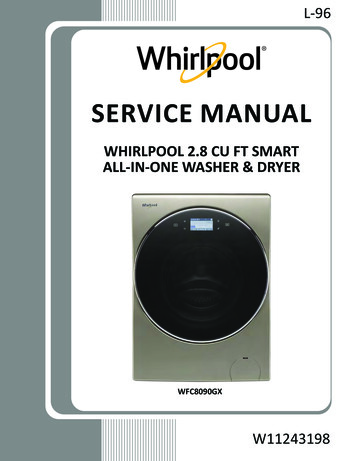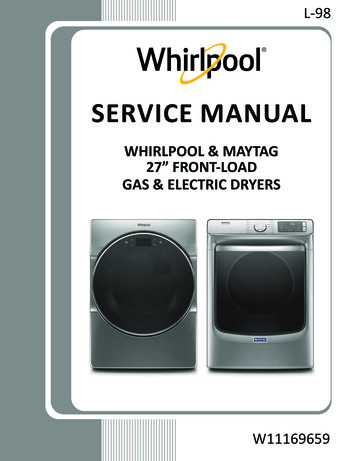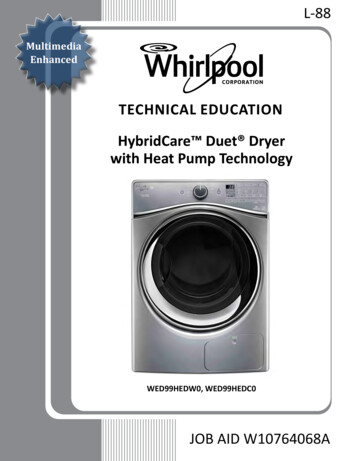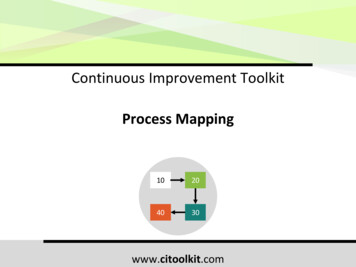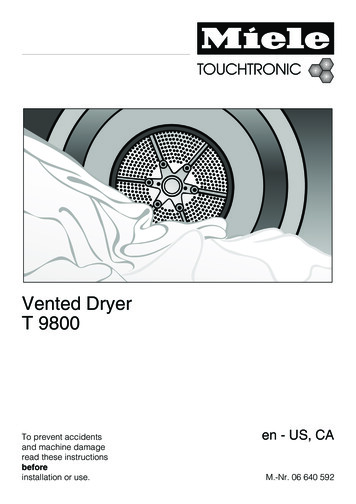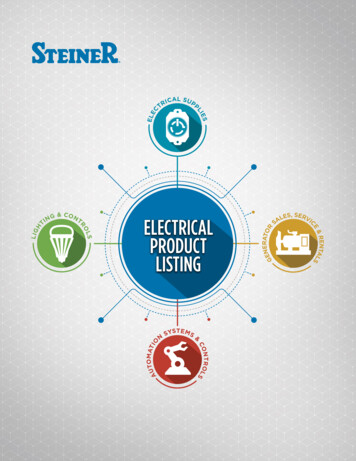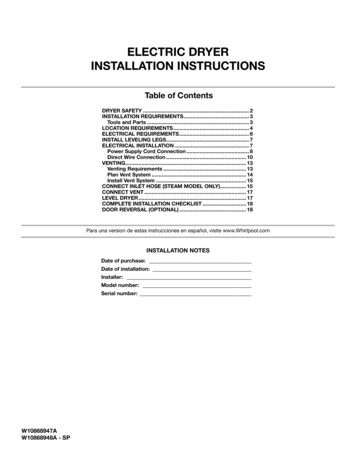
Transcription
ELECTRIC DRYERINSTALLATION INSTRUCTIONSTable of ContentsDRYER SAFETY. 2INSTALLATION REQUIREMENTS. 3Tools and Parts. 3LOCATION REQUIREMENTS. 4ELECTRICAL REQUIREMENTS. 6INSTALL LEVELING LEGS. 7ELECTRICAL INSTALLATION. 7Power Supply Cord Connection. 8Direct Wire Connection. 10VENTING. 13Venting Requirements. 13Plan Vent System. 14Install Vent System. 15CONNECT INLET HOSE (STEAM MODEL ONLY). 15CONNECT VENT. 17LEVEL DRYER. 17COMPLETE INSTALLATION CHECKLIST. 18DOOR REVERSAL (OPTIONAL). 18Para una version de estas instrucciones en español, visite www.Whirlpool.comINSTALLATION NOTESDate of purchase:Date of installation:Installer:Model number:Serial number:W10868947AW10868948A - SP1
DRYER SAFETY2
INSTALLATION REQUIREMENTSParts supplied (all models):TOOLS AND PARTSGather the required tools and parts before starting installation.Tools needed:Leveling legs (4)Parts supplied (steam models):Flat-blade screwdriver#2 Phillips screwdriver“Y” connectorWire stripper (direct wireinstallations)2' (0.6 m) inlet hoseTin snips (new ventinstallations)Rubber washerParts package is located in dryer drum. Check that all partsare included.NOTE: Do not use leveling legs supplied with dryer if installingwith a pedestal or a stack kit.1/4" and 5/16" nut driver(recommended)Adjustable wrench thatopens to 1" (25 mm) orhex-head socket wrenchParts needed: (Not supplied with dryer) Vent clamps Vent elbows and vent workParts needed (steam models):Utility knifeTape measure5' (1.52 m) inlet hoseAdditional parts may be required, depending on your installation.Check local codes. Check existing electrical supply and venting.Read “Electrical Requirements” and “Venting Requirements”before purchasing parts.LevelCaulking gun andcompound (for installingnew exhaust vent)PliersIf using a power supply cord:Use a UL-listed power supply cord kit marked for use withclothes dryers. The kit should contain: A UL-listed 30-amp power supply cord, rated 120/240 voltminimum. The cord should be type SRD or SRDT and beat least 4 ft. (1.22 m) long. The wires that connect tothe dryer must end in ring terminals or spade terminalswith upturned ends. A UL-listed strain relief.Optional Equipment: (Not supplied with dryer)Refer to your Use and Care Guide for information aboutaccessories available for your dryer.3
LOCATION REQUIREMENTSDRYER DIMENSIONSCheck code requirements. Some codes limit, or do not permit,installing dryer in garages, closets, mobile homes, or sleepingquarters. Contact your local building inspector.Front view:27"(686 mm)383/4" Min.(984 mm)39" Max.(990 mm)Side view:You will need: A location allowing for proper exhaust installation.See “Venting Requirements.” A separate 30-amp circuit. If using power supply cord, a grounded electrical outletlocated within 2 ft. (610 mm) of either side of dryer.See “Electrical Requirements.” Floor must support dryer weight of 200 lbs. (90.7 kg).Also consider weight of companion appliance. Cold water faucets located within 4 ft. (1.2 m) of the waterfill valves and water pressure of 20 –120 psi (138– 827 kPa).You may use the water supply for your washer using thesupplied “Y” connector and a short hose (which you willneed to purchase). Level floor with maximum slope of 1" (25 mm) under entiredryer. If slope is greater than 1" (25 mm), install ExtendedDryer Feet Kit, Part Number 279810. If not level, clothesmay not tumble properly and automatic sensor cyclesmay not operate correctly. For garage installation, place dryer at least 18" (460 mm)above floor. If using a pedestal, you will need 18" (460 mm)to bottom of dryer. The dryer must not be installed or stored in an area whereit will be exposed to water and/or weather.IMPORTANT: Do not operate, install, or store dryer whereit will be exposed to water, weather, or at temperatures below40 F (4 C). Lower temperatures may cause dryer not toshut off at end of automatic sensor cycles, resulting in longerdrying times.Installation ClearancesFor each arrangement, consider allowing more space for easeof installation and servicing, spacing for companion appliances,and clearances for walls, doors, and floor moldings. Spacemust be large enough to allow door to fully open. Add spacingon all sides of dryer to reduce noise transfer. If a closet dooror louvered door is installed, top and bottom air openingsin door are required.Check code requirements. Some codes limit, or do not permit,installation of the dryer in garages, closets, mobile homes, orsleeping quarters. Contact your local building inspector.Back view:61/2"(165 mm)NOTE: Mostinstallationsrequire a minimumof 5" (127 mm)clearance behinddryer for exhaustvent with elbow.See “VentingRequirements.”Water inlet(Steammodels only)Vent/4"*(18 mm)297/8"*(759 mm)31/2"*(89 mm)61/8"*(156 mm)3*Approx. measurement.4Power supplycord/cable143/8"(365 mm)
Installation spacing for recessed area or closetinstallationCustom under counter installation:All dimensions show recommended and minimum spacingallowed. Additional spacing should be considered for ease ofinstallation and servicing. Additional clearances might be required for wall, door,floor moldings, and dryer venting. Additional spacing should be considered on all sidesof the dryer to reduce noise transfer. For closet installation with a door, minimum ventilationopenings in the top and bottom of the door are required.Louvered doors with equivalent ventilation openings areacceptable. Companion appliance spacing should also be considered.Recommended installation clearances (dryer only):18" min.(457 mm)0" - 5"*(0" - 127 mm)3"(76 mm)3"(76 mm)0"–5"*(0 mm–127 mm)1"*(25 mm)Mobile home – Additional installation requirements:This dryer is suitable for mobile home installations.The installation must conform to the Manufactured HomeConstruction and Safety Standard, Title 24 CFR, Part 3280(formerly the Federal Standard for Mobile home construction andSafety, Title 24, HUD Part 280) or Standard CAN/CSA-Z240 MH.Mobile home installations require:48 in. min.(310 cm2)2 Metal exhaust system hardware, available for purchasefrom your dealer. For further information, see “Assistanceor Service” section in your Use and Care Guide. Special provisions must be made in mobile homes to introduceoutside air into dryer. Openings (such as a nearby window)should be at least twice as large as dryer exhaust opening.24 in.2 min.(155 cm2)1"(25 mm)*0" (0 mm) spacing is allowed for straight-back venting only.For steam models only, inlet hose must not be kinked.Minimum installation clearances (dryer ar0" (0 mm) 0" (0 mm)**0" (0 mm) 0" (0 mm)**1” (25 mm) 0” (0 mm)**Top0" (0 mm)0" (0 mm)0” (0 mm)**0" (0 mm) spacing is allowed for straight-back venting only.5
ELECTRICAL REQUIREMENTSIt is your responsibility: To contact a qualified electrical installer. To be sure that the electrical connection is adequate andin conformance with the National Electrical Code, ANSI/NFPA 70 – latest edition and all local codes and ordinances.The National Electrical Code requires a 4-wire power supplyconnection for homes built after 1996, dryer circuits involvedin remodeling after 1996, and all mobile home installations.A copy of the above code standards can be obtained from:National Fire Protection Association, One Batterymarch Park,Quincy, MA 02269. To supply the required 3- or 4-wire, single phase, 120/240volt, 60 Hz, AC only electrical supply (or 3- or 4-wire, 120/208volt electrical supply, if specified on the serial/rating plate)on a separate 30-amp circuit, fused on both sides of the line.Connect to an individual branch circuit. Do not have a fusein the neutral or grounding circuit. Do not use an extension cord. If codes permit and a separate ground wire is used, it isrecommended that a qualified electrician determine thatthe ground path is adequate.Electrical ConnectionTo properly install your dryer, you must determine the type ofelectrical connection you will be using and follow the instructionsprovided for it here. This dryer is manufactured ready to install with a 3-wireelectrical supply connection. The neutral ground conductoris permanently connected to the neutral conductor (white wire)within the dryer. If the dryer is installed with a 4-wire electricalsupply connection, the neutral ground conductor must beremoved from the external ground connector (green screw),and secured under the neutral terminal (center or white wire)of the terminal block. When the neutral ground conductor issecured under the neutral terminal (center or white wire) ofthe terminal block, the dryer cabinet is isolated from theneutral conductor. The green ground wire of the 4-wire powercord must be secured to the dryer cabinet with the greenground screw. If local codes do not permit the connection of a neutralground wire to the neutral wire, see “Optional External Groundfor 3-Wire Connection” in the “Power Supply Cord Connection”section. A 4-wire power supply connection must be used when theappliance is installed in a location where grounding throughthe neutral conductor is prohibited. Grounding through theneutral is prohibited for (1) new branch-circuit installations after1996, (2) mobile homes, (3) recreational vehicles, and (4) areaswhere local codes prohibit grounding through the neutralconductors.If using a power supply cord:Use a UL-listed power supply cord kit marked for use withclothes dryers. The kit should contain: A UL-listed 30-amp power supply cord, rated 120/240volt minimum. The cord should be type SRD or SRDTand be at least 4 ft. (1.22 m) long. The wires that connectto the dryer must end in ring terminals or spade terminalswith upturned ends. A UL-listed strain relief.6If your outlet looks like this:Then choose a 4-wire power supply cord withring or spade terminals and UL-listed strainrelief. The 4-wire power supply cord, at least4 ft. (1.22 m) long, must have four 10-gaugecopper wires and match a 4-wire receptacle ofNEMA Type 14-30R. The ground wire (ground4-wire receptacle conductor) may be either green or bare. The(14-30R)neutral conductor must be identified by awhite cover.Then choose a 3-wire power supply cord withring or spade terminals and UL-listed strainrelief. The 3-wire power supply cord, at least4 ft. (1.22 m) long, must have three 10-gauge3-wire receptacle copper wires and match a 3-wire receptacleof NEMA Type 10-30R.(10-30R)If connecting by direct wire:Power supply cable must match power supply (4-wire or 3-wire)and be: Flexible armored cable or nonmetallic sheathed coppercable (with ground wire), covered with flexible metallicconduit. All current-carrying wires must be insulated. 10-gauge solid copper wire (do not use aluminum) at least5 ft. (1.52 m) long.
INSTALL LEVELING LEGSELECTRICAL INSTALLATIONFor power supply cord installations:1. Prepare dryer for leveling legsTo avoid damaging floor, place a large flat piece of cardboardfrom dryer carton under entire back edge of dryer. Firmlygrasp dryer body (not console panel) and gently lay dryerdown on cardboard.2. Screw in leveling legsBefore you start: disconnect power.1. Choose electrical connection typePower supply cord 4-wire receptacle(NEMA Type 14-30R).Go to “Power Supply Cord Connection.”DiamonddiamondmarkingmarkingExamine leveling legs and locate diamond marking. Screwlegs into leg holes by hand – use a wrench to finish turninglegs until diamond marking is no longer visible.Place a carton corner post from dryer packaging under eachof the 2 dryer back corners. Stand the dryer up. Slide thedryer on the corner posts until it is close to its final location.Leave enough room to connect the exhaust vent.Power supply cord 3-wire receptacle(NEMA Type 10-30R).Go to “Power Supply Cord Connection.”4-wire direct connection:Go to “Direct Wire Connection.”3-wire direct connection:Go to “Direct Wire Connection.”NOTE: If local codes do not permit connection of acabinet-ground conductor to neutral wire, go to “Optional3-wire connection.” This connection may be used witheither a power supply cord or a direct wire connection.7
For direct wire installations:Power Supply Cord ConnectionPower supply cord strain relief1. Attach power supply cord strain reliefABCDRemove the screws from a 3/4" (19 mm) UL-listed strain relief(UL marking on strain relief). Put the tabs of the two clampsections (C) into the hole below the terminal block opening(B) so that one tab is pointing up (A) and the other is pointingdown (D), and hold in place. Tighten strain relief screws justenough to hold the two clamp sections (C) together.2. Remove terminal block coverRemove hold-down screw and terminal block cover.2. Attach power supply cordto strain reliefPut power supply cord through the strain relief. Be sure thatthe wire insulation on the power supply cord is inside thestrain relief. The strain relief should have a tight fit with thedryer cabinet and be in a horizontal position. Do not furthertighten strain relief screws at this point.If your outlet looks like this:Power supply cord 4-wire receptacle(NEMA Type 14-30R):Go to “4-Wire Power Supply CordConnection” on this page.Power supply cord 3-wire receptacle(NEMA Type 10-30R):Go to “3-Wire Power Supply CordConnection” on page 9.8
4-Wire Power Supply Cord ConnectionIMPORTANT: A 4-wire connection is required for mobile homesand where local codes do not permit the use of 3-wire connections.3. Connect ground wireA4-wire receptacle(NEMA type 14-30R)F4-prong plugConnect ground wire (F) (green or bare) of power supply cordunder green external ground conductor screw (A). Tightenscrew.Spade terminals withupturned endsRing terminals4. Connect remaining wires1. Prepare to connect neutral groundwire and neutral wireEBARemove center terminal block screw (B). Remove neutralground wire (E) from green external ground conductor screw (A).Connect remaining wires under outer terminal block screws.Tighten screws. Finally, reinsert tab of terminal block coverinto slot of dryer rear panel. Secure cover with hold-downscrew. Now go to “Venting Requirements.”3-Wire Power Supply Cord ConnectionUse where local codes permit connecting cabinet-groundconductor to neutral wire.2. Connect neutral ground wireand neutral wireBECConnect neutral ground wire (E) and neutral wire (white orcenter) (C) of power supply cord under center terminal blockscrew (B). Tighten screw.3-wire receptacle (NEMAtype 10-30R)3-prong plugSpade terminals withupturned endsRing terminals9
Direct Wire Connection1. Remove center screwDirect wire strain relief1. Attach direct wire strain reliefBABCRemove center terminal block screw (B).2. Connect neutral wireBCUnscrew the removable conduit connector (A) and anyscrews from a 3/4" (19 mm) UL-listed strain relief (UL markingon strain relief). Put the threaded section of the strain relief(C) through the hole below the terminal block opening (B).Reaching inside the terminal block opening, screw theremovable conduit connector (A) onto the strain reliefthreads and tighten securely.2. Attach direct wire cable to strain reliefConnect neutral wire (white or center) (C) of power supply cordunder center terminal block screw (B). Tighten screw.3. Connect remaining wiresPut direct wire cable through the strain relief. The strainrelief should have a tight fit with the dryer cabinet and be ina horizontal position. Tighten strain relief screw against thedirect wire cable.If your wiring looks like this:4-wire direct connection:Go to “4-Wire Direct Wire Connection”on this page.Connect remaining wires under outer terminal block screws.Tighten screws. Finally, reinsert tab of terminal block coverinto slot of dryer rear panel. Secure cover with hold-downscrew. Now go to “Venting Requirements.”103-wire direct connection:Go to “3-Wire Direct Wire Connection”on page 11.
4-Wire Direct Wire ConnectionIMPORTANT: A 4-wire connection is required for mobile homesand where local codes do not permit 3-wire connections.4. Connect ground wire1. Prepare your 4-wire cablefor direct connection31 2" )m(89 mA1" )m(25 mF(127 5"mm)Direct wire cable must have 5 ft. (1.52 m) of extra length sodryer may be moved if needed.Strip 5" (127 mm) of outer covering from end of cable,leaving bare ground wire at 5" (127 mm). Cut 11/2" (38 mm)from remaining 3 wires. Strip insulation back 1" (25 mm).Shape ends of wires into hooks.Connect ground wire (green or bare) (F) of direct wire cableunder green external ground conductor screw (A). Tightenscrew.5. Connect remaining wires2. Prepare to connect neutral groundwire and neutral wireEBARemove center terminal block screw (B). Remove neutralground wire (E) from green external ground conductor screw (A).Place hooked ends of remaining direct wire cable wires underouter terminal block screws (hooks facing right). Squeezehooked ends together and tighten screws. Finally, reinsert tabof terminal block cover into slot of dryer rear panel. Securecover with hold-down screw. Now go to “Venting Requirements.”3-Wire Direct Wire ConnectionUse where local codes permit connecting cabinet-groundconductor to neutral wire.3. Connect neutral ground wire andneutral wire1. Prepare your 3-wire cablefor direct connectionB1" )m(25 mEC3½(89 m "m)Direct wire cable must have 5 ft. (1.52 m) of extra length sodryer may be moved if needed.Connect neutral ground wire (E) and placehooked end (hook facing right) of neutral wire(white or center wire) (C) of direct wire cableunder center screw of terminal block (B).Squeeze hooked ends together and tighten screw.Strip 31/2" (89 mm) of outer covering from end of cable. Stripinsulation back 1" (25 mm). If using 3-wire cable with groundwire, cut bare wire even with outer covering. Shape wire endsinto hooks.11
Optional External Ground for 3-WireConnection (Power Supply Cord Shown)2. Remove center screwIMPORTANT: You must verify with a qualified electricianthat this grounding method is acceptable before connecting.1. Prepare to connect neutral groundBwire and neutral wireEBRemove center terminal block screw (B).A3. Connect neutral wireInstall the correct strain relief for your electrical connectionmethod, as shown on page 8 or 10.BRemove center terminal block screw (B). Remove neutralground wire (E) from green external ground conductor screw (A).C2. Connect neutral ground wireand neutral wireBEPlace hooked end of neutral wire (whiteor center) (C) of direct wire cable undercenter terminal block screw (B), hookfacing right. Squeeze hooked end together.Tighten screw.C4. Connect remaining wiresConnect neutral ground wire (E) and neutral wire (white orcenter wire) (C) of power supply cord or cable under centerterminal block screw (B). Tighten screw.3. Connect remaining wiresPlace hooked ends of remaining direct wire cable wires underouter terminal block screws (hooks facing right). Squeezehooked ends together and tighten screws. Finally, reinsert tab ofterminal block cover into slot of dryer rear panel. Secure coverwith hold-down screw. Now go to “Venting Requirements.”Place ends of remaining wires under outer terminal blockscrews. Tighten screws.12
4. Connect external ground wireRigid metal vent: Recommended for best drying performance and to avoidcrushing and kinking.Flexible metal vent: (acceptable only if accessible to clean) Must be fully extended and supported in final dryer location. Remove excess to avoid sagging and kinking that may resultAin reduced airflow and poor performance. Do not install in enclosed walls, ceilings, or floors.G The total length should not exceed 73/4 ft. (2.4 m). The length of flexible metal vent used must be includedin the overall vent system design as shown in the “VentSystem Charts.”Connect a separate copper ground wire (G) under the greenexternal ground conductor screw (A) to an adequate ground.Finally, reinsert tab of terminal block cover into slot of dryerrear panel. Secure cover with hold-down screw. Now go to“Venting Requirements.”VENTINGNOTE: If using an existing vent system, clean lint from entirelength of the system and make sure exhaust hood is not pluggedwith lint. Replace plastic or metal foil vents with rigid metalor flexible metal vents. Review “Vent System Charts” and, ifnecessary, modify existing vent system to achieve best dryingperformance.Exhaust hoods:Venting Requirements An exhaust hood should cap the vent to keep rodents andinsects from entering the home. Must be at least 12" (305 mm) from ground or any objectthat may obstruct exhaust (such as flowers, rocks, bushes,or snow). Do not use an exhaust hood with a magnetic latch.Recommended Styles:Louvered HoodBox HoodAcceptable Style:WARNING: To reduce the risk of fire, this dryer MUST BEEXHAUSTED OUTDOORS.IMPORTANT: Observe all governing codes and ordinances.Dryer exhaust must not be connected into any gas vent,chimney, wall, ceiling, attic, crawlspace, or a concealed spaceof a building. Only rigid or flexible metal vent shall be used forexhausting.Angled HoodElbows: 45 elbows provide better airflow than 90 elbows.4"(102 mm)GoodBetter4" (102 mm) heavy metal exhaust vent Only a 4" (102 mm) heavy metal exhaust vent and clampsmay be used. Do not use plastic or metal foil vent.13
Clamps: Use clamps to seal all joints. Exhaust vent must not be connected or secured with screwsor other fastening devices that extend into interior of ductand catch lint. Do not use duct tape.Improper venting can cause moisture and lint to collectindoors, which may result in:Moisture damage to woodwork, furniture, paint, wallpaper,carpets, etc.Optional exhaust installations:This dryer can be converted to exhaust out the right side,left side (all models except long vent), or through the bottom.If you prefer, you may contact your local dealer to have thedryer converted.Housecleaning problems and health problems.Plan Vent SystemChoose your exhaust installation typeRecommended exhaust installation:BCADEFABCA. Standard rear offset exhaust installationB. Left- or right-side exhaust installationC. Bottom exhaust installationGSpecial provisions for mobile homes:Exhaust vent must be securely fastened to a noncombustibleportion of mobile home and must not terminate beneath themobile home. Terminate exhaust vent outside.BHA.B.C.D.14DryerElbowWallExhaust hoodE.F.G.H.ClampsRigid metal or flexible metal ventVent length necessary to connect elbowsExhaust outlet
Determine vent path: Select route that will provide straightest and most directpath outdoors. Plan installation to use fewest number of elbows and turns. When using elbows or making turns, allow as much roomas possible. Bend vent gradually to avoid kinking. Use as few 90 turns as possible.Install Vent System1. Install exhaust hood12" min.(305 mm)Determine vent length and elbows needed for bestdrying performance: Use the following “Vent System Charts” to determine typeof vent material and hood combinations acceptable to use.NOTE: Do not use vent runs longer than those specifiedin “Vent System Charts.”Exhaust systems longer than those specified will: Shorten life of dryer. Reduce performance, resulting in longer drying timesand increased energy usage.The “Vent System Charts” provide venting requirements thatwill help achieve best drying performance.12" min.(305 mm)Install exhaust hood and use caulking compound to sealexterior wall opening around exhaust hood.2. Connect vent to exhaust hoodStandard Vent System ChartNumber of90 elbowsTypeof ventAngledhoods0Rigid metal64 ft. (20 m)1Rigid metal54 ft. (16.5 m)2Rigid metal44 ft. (13.4 m)3Rigid metal35 ft. (10.7 m)4Rigid metal27 ft. (8.2 m)Long Vent System ChartNumber of90 elbowsTypeof ventAngledhoods0Rigid metal160 ft. (48.8 m)1Rigid metal150 ft. (45.7 m)2Rigid metal140 ft. (42.7 m)3Rigid metal130 ft. (39.6 m)4Rigid metal120 ft. (36.6 m)Vent must fit over the exhaust hood. Secure vent to exhausthood with 4" (102 mm) clamp. Run vent to dryer location usingstraightest path possible. Avoid 90 turns. Use clamps to sealall joints. Do not use duct tape, screws, or other fasteningdevices that extend into interior of vent to secure vent,because they can catch lint.CONNECT INLET HOSE(STEAM MODEL ONLY)For non-steam models, skip to “Connect Vent.”The dryer must be connected to the cold water faucet usingnew inlet hoses (not supplied). Do not use old hoses.NOTE: Replace inlet hoses after 5 years of use to reduce therisk of hose failure. Record hose installation or replacementdates on the hoses for future reference.Periodically inspect and replace hoses if bulges, kinks, cuts,wear, or leaks are found.1. Turn cold water off, remove hose,and replace rubber washerTo determine if your model has a long vent system, refer tothe type code located on the serial number plate in the innerdoor well. Example: An electric model would be DALV (LongVent) – ELE – XXXXXXX-XXX.NOTE: For long vent systems, use of box/louvered hoods willimprove venting, regardless of length.Turn cold water faucet off and remove washer inlet hose.Remove old rubber washer from inlet hose and replace withnew rubber washer.15
2. Attach short hoseand “Y” connector5. Attach long hose to dryer fill valveand tighten couplingAttach 2 ft (0.6 m) inlet hose to cold water faucet. Screw oncoupling by hand until it is seated on faucet. Then attach “Y”connector to male end of the 2 ft (0.6 m) inlet hose. Screw oncoupling by hand until it is seated on connector.3. Tighten couplingsRemove protective cap fromwater inlet valve. Attach other endof long hose to fill valve at bottom of dryerback panel. Screw on coupling by hand until it is seated onfill valve connector. Using pliers, tighten the couplings anadditional two-thirds turn.NOTE: Do not overtighten. Damage to the couplingcan result.6. Turn on cold water faucetUsing pliers, tighten the couplings with additionaltwo-thirds turn.NOTE: Do not overtighten. Damage to the coupling can result.4. Attach long hose to “Y”connector and tighten couplingsCheck that the water faucets are turned on.7. Check for leaksAttach one of the 5 ft (1.5 m) inlet hose ends to the “Y”connector. Attach washer cold inlet hose to other side of“Y” connector. Screw on coupling by hand until it is seatedon connector. Using pliers, tighten the couplings an additionaltwo-thirds turn.NOTE: Do not overtighten. Damage to the coupling can result.Check for leaks around “Y” connector, faucet, and hoses.16
CONNECT VENT1. Connect vent to exhaust outletLEVEL DRYER1. Level dryerPlacelevel hereUsing a 4" (102 mm) clamp, connect vent to exhaust outletin dryer. If connecting to existing vent, make sure vent isclean. Dryer vent must fit over dryer exhaust outlet and insideexhaust hood. Check that vent is secured to exhaust hoodwith a 4" (102 mm) clamp.Check levelness of dryer fromside to side. Repeat from front to back.NOTE: The dryer must be level for the moisture sensingsystem to operate correctly.2. Move dryer to final locationNot LevelLEVELNot Level2. Adjust leveling legsMove dryer to final location, taking care not to crush orkink vent.After dryer is in place, remove corner posts and cardboardfrom under dryer.If dryer is not level, prop up using a wood block, use wrenchto adjust legs up or down, and check again for levelness.Once dryer is level, make sure all four legs are snug againstthe floor and dryer does not rock.17
COMPLETE INSTALLATIONCHECKLISTq Check that all parts are now installed. If there is an extrapart, go back through steps to see what was skipped.q Check that you have all of your tools.q Dispose of/recycle all packaging materials.q Be sure the water faucets are on.q Check for leaks around “Y” connector, faucet, and hoses.q Check dryer’s final location. Be sure vent is not crushedor kinked.q Check that dryer is level. See “Level Dryer.”q Remove film on console and any tape remaining on dryer.q Wipe dryer drum interior thoroughly with a damp clothto remove any dust.q Read “Dryer Use” in your Use and Care Guide.q For power supply cord installation, plug into a groundedoutlet. For direct wire installation, turn on power.DOOR REVERSAL (OPTIONAL)The following instructions are for models with round andsquare-shaped doors.Tools needed:Min. 8" long TORX T25 †screwdriver#2 Phillips screwdriverReverse door swing round-shaped door with flatglass – single handle1. Remove door from dryerq If you live in a hard water area, use of a water softener isrecommended to control the buildup of scale through thewater system in the dryer. Over time, the buildup of limescale may clog different parts of the water system, which willreduce product performance. Excessive scale buildup maylead to the need for certain part replacement or repair.q Select a Time Dry heated cycle, and start dryer. Do not selectAir Only Temperature setting.If dryer will not start, check the following: Controls are set in a running or “On” position. Start button has been pushed firmly. Dryer is plugged into an outlet and/or electrical supply. Household fuse is intact and tight, or circuit breakerhas not tripped. Dryer do
This dryer is suitable for mobile home installations. The installation must conform to the Manufactured Home Construction and Safety Standard, Title 24 CFR, Part 3280 (formerly the Federal Standard for Mobile home construction and Safety, Title 24, HUD Part 280) or Standard CAN/CSA-Z24
